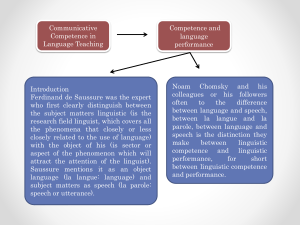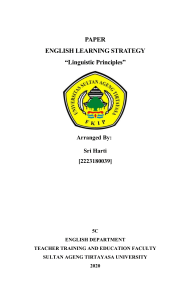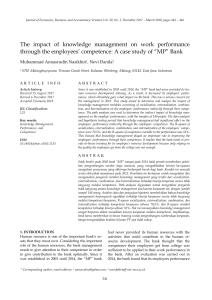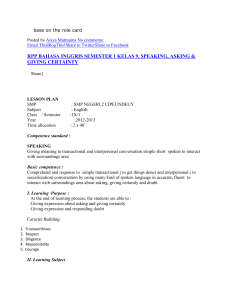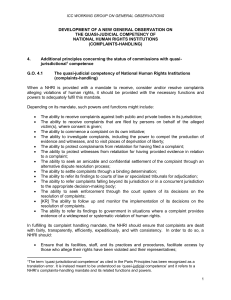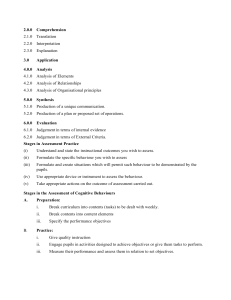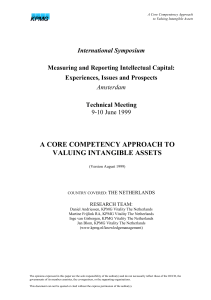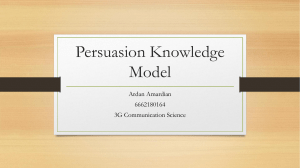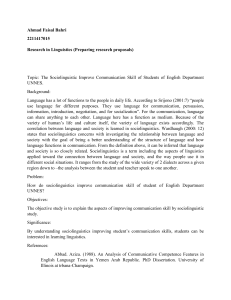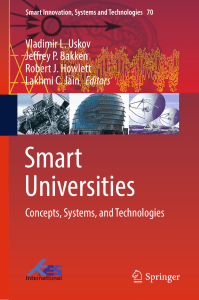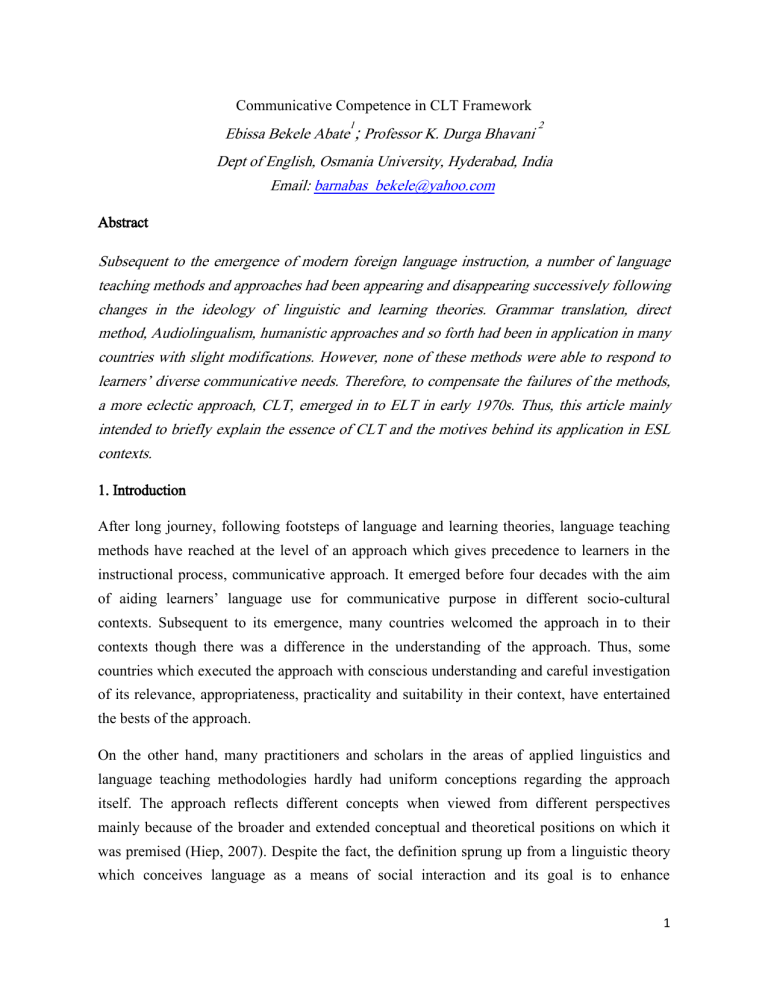
Communicative Competence in CLT Framework 1 Ebissa Bekele Abate ; Professor K. Durga Bhavani 2 Dept of English, Osmania University, Hyderabad, India Email: [email protected] Abstract Subsequent to the emergence of modern foreign language instruction, a number of language teaching methods and approaches had been appearing and disappearing successively following changes in the ideology of linguistic and learning theories. Grammar translation, direct method, Audiolingualism, humanistic approaches and so forth had been in application in many countries with slight modifications. However, none of these methods were able to respond to learners’ diverse communicative needs. Therefore, to compensate the failures of the methods, a more eclectic approach, CLT, emerged in to ELT in early 1970s. Thus, this article mainly intended to briefly explain the essence of CLT and the motives behind its application in ESL contexts. 1. Introduction After long journey, following footsteps of language and learning theories, language teaching methods have reached at the level of an approach which gives precedence to learners in the instructional process, communicative approach. It emerged before four decades with the aim of aiding learners’ language use for communicative purpose in different socio-cultural contexts. Subsequent to its emergence, many countries welcomed the approach in to their contexts though there was a difference in the understanding of the approach. Thus, some countries which executed the approach with conscious understanding and careful investigation of its relevance, appropriateness, practicality and suitability in their context, have entertained the bests of the approach. On the other hand, many practitioners and scholars in the areas of applied linguistics and language teaching methodologies hardly had uniform conceptions regarding the approach itself. The approach reflects different concepts when viewed from different perspectives mainly because of the broader and extended conceptual and theoretical positions on which it was premised (Hiep, 2007). Despite the fact, the definition sprung up from a linguistic theory which conceives language as a means of social interaction and its goal is to enhance 1 communicative competence via expression, interpretation and negotiations of meaning. Similarly, CLT was conceived as an approach which contains spectrum of methods intended to develop learners’ competence in target language use (Celce-Murcia, 1991). Moreover, the approach colligates multiple methods that focus on aiding learners to communicate sensibly in the target language (Nunan, 1999). The views indicate that the aim of the approach is to advance learners’ communicative competence in the target language via carefully designed procedures of teaching integrated skills which warrant continuum relationship between language and communication. The objective of this abstract is: (1) to disclose the essence of CLT approach; and (2) to address the goals of the approach which is termed as communicative competence. 2. What is CLT? CLT is a recent most widely used foreign/second language teaching approach introduced in the early 1970s. Because of some reasons the approach has been defined and understood differently by different scholars. Despite the fact, most definitions start with a theory which dictates language as a vehicle for expression of meaning; and whose goal is to enhance communicative competence (Savignon, 1972). As to (Richards & Rodgers, 2001), CLT is regarded as an approach to language teaching which reflects certain model, research paradigm/theory. The approach covers varieties of methods that focus on helping learners communicate meaningfully in the target language in varied socio-cultural contexts. Methods, procedures, techniques and activities in CLT favor learners and their learning wants. Therefore, the goal is to enhance meaningful communication in the target language through carefully designed procedures of teaching integrated skills which grant consolidation between language and communication. Richards set CLT as “a set of principles about the goals of language teaching, how learners learn a language, the kinds of classroom activities that best facilitate learning, and the roles of teachers and learners in the classroom” (Richardes, 2006, p. 2). CLT emanated from integrated disciplines including linguistics, sociology, anthropology, philosophy, psychology, educational research, and the purpose is the application of methods that promote the development of purposive language use via learners’ participation in the pedagogic process. On top, the approach considers socio-political nature of langue learning and follows careful integration of policymakers, linguists, researchers, educators, teachers and 2 learners in planning, execution and evaluation of communicative instructional curricula (Savignon, 2002). 3. What Does CLT Entails? As indicated earlier, the very definition of CLT begins with an indication of the primary goal of the approach. Accordingly, the elemental rational behind the application of CLT was to develop learners’ communicative ability. Similarly, Savignon (1972) also claimed that the goal of CLT is to enhance learners’ communicative competence. The final destiny of the approach is thus the formulation of learners’ communicative ability which may include different sub-sectors: grammatical competence, strategic competence, discourse competence and sociolinguistic competence. The approach primarily emanated from cognitive learning perspective that humans have instinctive cognitive ability to comprehend the subsectors of communicative competence. The sectors are synchronized together and cannot be complete in the absence of the other. 4. The Essence of Communicative Competence Autonomous, group learning and communicative functions emerged to be the main concern of linguists and learning theorists since early 1970s. As a result, applied linguists and educators began to advocate an approach which enhances learners’ communicative competence through various cooperative learning activities (Farell & Jacobs, 2011). Afterwards, applied linguists, educators, teachers and learners have switch off their attention from traditional and solitude approach which gives precedence to the mastery of structural aspects of language to the one which promotes communicative competence in second/foreign language classes (Mehmet, 2006). The central concept in CLT, communicative competence, has been interpreted and represented by different scholars from diverse fields (Hymes, 1971); (Widdowson, 1983); (Canale & Swian, 1980); (Bachman, 1990); (Brown, 2007). Hymes introduced the concept of communicative competence and conceived it as the ability to encode and decode messages and to negotiate meaning interpersonally within particular contexts (Hymes, 1971). He further contends that communicative competence is not constrained only to the mastery of representations, interpretation, negotiation and analysis of meaning, but also the knowhow of what to say to whom, when and in what situation (ibid.). Widdowson, after making distinction 3 between competence and capacity, defined communicative competence in terms of knowledge of linguistics and sociolinguistic conventions, and put more focus on actual language use (Widdowson,1983). Canale and Swine understood communicative competence as combination of underlying system of knowledge and skills required for communication. Language knowledge as to their view contains: knowledge of structural principles, socio-cultural contexts, and discourse principles. Conversely, the skill dimension in communicative competence refers to how individuals use the language knowledge at their disposal in actual communication (Canale, 1983). Communicative competence is “the ability to use language in a true communicative setting, which is in a dynamic exchange in which linguistic competence must adapt itself to the total informational input, both linguistic and paralinguistic of one or more interlocutors” (Savignon, 1972, p.8). Literature in second and foreign language pedagogy indicates that communicative competence is characterized by unique features as dynamism; inter personality, relativity and conceptuality. But some researchers and practitioners (Bachman, 1990); (Stern, 1986); (Tylor, 1988) associate communicative competence with language proficiency which do not bother much about language knowledge, but an abstract, mental and unobservable ability used in the context of communication (Richards, 1985a). Researchers were also insisted in exploring out the earnest source of linguistic and socio cultural competences and how it could be acquired and developed in children’s life time. Hymes presented basic foundation of communicative competence claiming that “children acquire socio-cultural rules such as when to speak, when not, what to talk about, with whom, in what manner at the same time as they acquire knowledge of grammatical rules” (Hymes, 1972, p. 277). The socio-cultural environment in which children grow up is fertile ground for inception and development of communicative competence mainly in their first and primary language. But, in the case of second/foreign language learners, communicative competence emerges through the use of CLT principles and practices in foreign/second language contexts. All the competences of communication were synchronized together to serve common purpose of developing learners’ communicative proficiency and it is impossible to detach one from the other. ELT instruction in classroom context should fairly treat the components of communicative competences, for the general goal cannot likely be attained in the absence of the other. 4 5. Models of Communicative Competence As to the literature in second/foreign language teaching, learning and assessment, there are widely receipted models of language proficiency that teachers are supposed to teach, learners are likely to master, testers are expected to measure, and program evaluators must evaluate in line with it. The most commonly acknowledged models include Canale and Swine’s Model, Bachman’s Model and Common European Framework Model. The details will be taken-up separately. 5.1 Canale and Swine’s’ Model The model introduced by (Canale & Swian, 1980), was deviant from previous models for it regards communication as an active process which can be realized through language use. The model includes four sub-sectors: grammatical, sociolinguistics, strategic and discourse competences (Canale,1983). Effective execution of communicative approach (CLT) results in the formation of the aforementioned communicative competence sectors. In simple expression, the practitioners recommended learners, teachers, materials writers and testers to align their pedagogic practices in accordance with the proposed theoretical framework of communicative competences. The scholars described grammatical competence as an aspect of competence which encompasses the knowledge of lexical items and rules of morphology, syntax, semantics and phonology (Canale & Swine, 1980). In the construction of grammatical competence, as a component of communicative competence, the readers have specified no single aspect of grammar to be selected over the others. Rather, they stress that grammatical competence will be an important concern for any communicative approach whose goal is providing learners with the knowledge of how to determine and express accurately the literary meaning of the utterance. Sociolinguistic competence as (Canale & Swine, 1980), refers to socio-cultural rules of use and rules of discourse. The proper mastery of these rules is crucial in interpreting utterances for social meaning particularly when there is low level of transparency between the literal meaning of an utterance and the speakers’ intentions. Socio-cultural rules of use specify the ways in which the utterances are produced and understood appropriately with respects to the components of communicative events. The focus of these rules is on the extent to which 5 certain propositions and communicative functions are appropriate within a given socio-cultural groups based on contextual factors as topic, role of the participants, setting and norm of the interaction. In addition, the secondary concern of sociolinguistic competence was the extent to which appropriate attitude, registrar and styles are conveyed by particular grammatical forms within a given socio-cultural context. Strategic competence is verbal and non-verbal communication strategy that can be called in, to correct breakdowns in communication due to performance variables or insufficient competences (Canale & Swian, 1980). It is systematic means of mending for communicative failures created in an interaction. As to this model, strategic competence integrates two major components. The first aspect is the one that relates to grammatical competence (how to paraphrase grammatical forms that one has not mastered or cannot recall momentarily), and the second aspect relates to sociolinguistic competence (various role playing strategies (how to address strangers when we are unsure of their social status). Knowledge of sociolinguistic rules many be helpful at the beginning stage of second language learning, and it is expected that the need for certain strategies may change as function of age and second language proficiency. Moreover, the strategies are most likely to be acquired through experience in real life interaction, but not through classroom practices that integrate no meaningful communication. (Canale, 1983), described discourse competence as mastery of rules that determine ways in which forms and meanings are combined to achieve a meaningful unity of spoken or written texts. The unity of a text is enabled by cohesion in form and coherence in meaning. Cohesion is achieved by the use of cohesive devices which help to link individual sentences and utterances to a structural whole. The means for achieving coherence for instance repetition, progression, consistency, relevance of ideas etc., enable the organization of meaning, i.e. establish a logical relationship between groups of utterances. The readers proposed the value of the framework in four main areas of second language teaching: syllabus design, teaching methodology, teacher training and material development. The model will be further illustrated under figure-2.1. 6 Communicative Competence Grammatical Competence Strategic Competence Sociolinguistic Competence Discourse Competence Figure-5.1: Canale and Swine’s Model of Communicative Competence (CC) 5.2 Bachman’s Model of Competence Canale & Swian’s model was the most influential frameworks of communicative competence in the context of foreign language teaching, learning and testing. Later, Bachman introduced a model which capitalizes on the central role of meta-cognitive strategies that explain the interaction of knowledge and affective components of language use (Fulcher & Davidson, 2007). He believed that the current framework extends the former models as “it attempts to characterize the process in which various components interact with each other and with context in which language use occurs” (Bachman, 1990, p. 81). Bachman criticized the earlier models for they dismantled the integrity of skills and linguistic components, and their failures to state the relationship between the two, arguing that “it was difficult to see whether the knowledge components were understood in their theories as simply manifested in skills in different modalities and channels, or whether they are fundamentally different in quality” (Bachman, 1990:83). Thus, Bachman developed three central components for language ability that are essential to define ones competence in effective language use for communication. These includes: strategic competence and psychophysiological mechanisms (Bachman, 1990, p. 84). 7 The first component termed as language competence consists of organizational competence and pragmatic competence. The organizational competence is further divided into grammatical competence and textual competence. Canale & Swine’s grammatical competence and Bachman’s language competence are consonant with each other in that, both comprise of abilities to control the formal structure of language. Textual competence however, pertains to the knowledge of conventions for cohesion and coherence, and rhetorical organization of written and spoken texts. Moreover it includes conventions for language use in conversations, containing establishing, starting, maintaining and terminating conversations. Bachman’s textual competence can, thus, be said to have qualities of both the parts of (Canale & Swian, 1980) discourse competence as well as the part of strategic competence. Bachman’s pragmatic competence, the other component in language competence, focuses on the relationship between what one says in his/her communicative acts and what functions he/she intends to perform through his/her utterances. This concerns illocutionary force of an utterance, or the knowledge of pragmatic conventions for performing acceptable language functions (Bachman,1990), which embodies illocutionary competence under the pragmatic competence. Illocutionary competence enables a speaker to use his/her language to serve varieties of functions and a hearer to interpret the illocutionary force of an utterance or discourse required of him/her. One needs more than illocutionary competence to successfully execute an act to intend certain communicative function. S/he must have knowledge of appropriateness based on the language use in context in which s/he finds her/himself when engaging in a communicative exchange. Bachman calls it sociolinguistics as an annex of pragmatic competence. More precisely, Bachman discusses four abilities pertaining to sociolinguistic competence: the ability to be sensitive to regional and social language varieties; the ability to be sensitive to differences in register; the ability to produce and interpret utterances based on naturalness of language use, or what (Pawley & Syder, 1983) refer to as a native-like way of communication, and ability to understand cultural reference and figures of speech (Bachman, 1990, pp. 95-98). In Bachman’s framework, sociolinguistic competence and illocutionary competence were categorized together to form speaker’s pragmatic competence, which also associated with grammatical competence to constitute ones’ own comprehensive language competence. 8 Strategic competence refers to the psycholinguistic model of speech production that subsumes planning and excision phases. Bachman criticized strategic competence described in interactional and production approach, as well as recent models on (Canale & Swian, 1980) for it undermines the role of strategic competence in communicative language use. He claims that strategic competence is a valuable part of communicative language use, not just that in which the language abilities are deficient and must be compensated by other means. He advanced (Faerch & Kasper, 1984)’s formulation providing general descriptions of strategic competence in communicative language use adding components like: assessment, planning and execution (Bachman, 1990). The last competence of communicative ability as to Bachman’s framework includes psychophysiological mechanisms involved in language use. It refers to learners’ competence in using auditory (sound) and visual (light) as well as neuromuscular skills in communication (reception and production) process which constitutes an important aspect of language ability. Bachman’s framework of language ability seems complex and difficult to understand in relation to other frameworks. But it is so impressive more broad to widen readers’ understanding of the level to which we teach, learn and assess learners’ langue performance. The diagrammatic illustration bellow (fig 1.2) could make the difficulties of understanding the model more comprehensible. 9 Communicative Language Ablity (CLA) Strategic Competence Language Competence Organizational Competence Gramatical Competence Textual Competence Psychophysiological Mechanisms Pragmatic Competence Illoctionary Competence Sociolinguistic Competence Figure- 5.2: Bachman’s Framework of Communicative Language Ability (CLA) 10 5.3 Common European Framework Model The CEF model is a recent trend meant for language learning, teaching and assessment. The document describes common bases for elaboration of curriculum guides, syllabus, examination, textbooks and other instructional practices across Europe. The model describes what learners have to learn in order to use a language for interaction, and what language and skills they have to develop so as to be able to act effectively. The model also defines levels of proficiency which allows learners’ progress to be measured at each stages of learning on lifelong bases. CEF model subsumes three genres of competences: linguistic, sociolinguistic and pragmatics (CEF, 2001). Linguistic competence in CEF model refers to learners’ ability to use language items for communicative purposes. It stresses on mastery of phonology, morphology, semantics, lexis, grammar, orthographic and orthoepic competences (CEF, 2001). Sociolinguistic competence on the other hand refers to the control of intrinsic wills and skills for appropriate language use in various socio-cultural contexts. The model focuses on some comprehensive aspects of competences as politeness conventions; markers of social relations between generations; interpretation and expression of flock wisdom, register variation, dialects and accentuates. Sociolinguistic competence has strong zeal to affect all interaction among representatives of diverse cultures, though participants may often be unaware of its influence. Pragmatic competence in Common European Framework (CEF) model subsumes three major components: The functional uses of language resources, drawing on scenarios or scripts of interactional exchanges; the mastery of discourse, cohesion and coherence, the identification of text types and forms, irony and satire. Moreover, pragmatic competence also includes planning competence which refers to logical and procedural sequence of messages in accordance with interactional and transactional schema. Strategic competence in Common European Framework (CEF) model is dedicated to the discussion of communicative language use. The competence is conceived as strategy used in the broadest sense. It is not only constrained and limited to schemes of maintaining communication breakdown; but also on the use of comprehensive communication strategies. As to Common European Framework model, the use of strategies can be compared with the application of meta-cognitive principles on different forms of language activities: reception, interaction, production and meditation. The diagram below provides précis explanation of the model. 11 Communicative Competences Linguistic Competence Sociolinguistic competence Discourse Competence Pragmatic Competence Functional Competence Design Competence Figure-5.3: CEF Model of Communicative Language Competence (CLC) To windup, the three communicative competence models discussed above though seem different in many respects; all share language competence as common denominator for all models. Moreover, the common goal of the models is to transverse a message to foreign language practitioners including: planners, learners, teachers, testers and material writer to align their pedagogical action in line with the proposed components of communicative proficiency. But because of its simplicity and comprehensive nature, Canale & Swine’s model have got extensive and wider popularity in the description of goals in language learning, teaching, testing and research, even after the introduction of the most inclusive and recent trends. 6. Conclusions CLT is the most recent and extensively used foreign/second language pedagogy in many parts of the world. In fact there are some the so called ‘recent language teaching approaches’ like Natural approach, Task based approach, Language emersion, lexical approaches, content based approach, cooperative language learning approach which emerged in post CLT. Even the so called ‘post method conditions’ were introduced science the 2000. However, all the methods were explicitly relied on CLT approach. I mean some of the approaches were not even widely used as EFL/ESL language instruction; while, others were not complete language teaching approaches (lexical approach). But CLT served as a backbone for all of these EFL/ESL approaches. The goal for CLT as has been indicated in the earlier discussion is the promotion of learners’ communicative competence. Here, the competences were 12 stratified in to diverse categories on the bases of diverse models: Canale & Swine model, Bachman model and Common European Framework models. Thus EFL/ESL curriculum planners, teachers, testers and learners must consider these models and their respective subsectors in running pedagogical practices in their specific contexts. The whole practice of language teaching directly based on the communicative competence subsectors. Thus as the comprehensive communicative competence cannot be attained in the absence of one of the communicative subsectors, the practitioners must pay due attention to each of the competence subsectors. 7. References Bachman, L.(1990). Fundamental Considerations in Language Testing. Oxford: Oxford University Press. Brown, H. (2007). Principles of Language learning and Teaching (5th ed.). Longman: Person Education. Canale, M. (1983). From communicative competence to communicative language pedagogy. In R. JC, & S. RW, Language and Communication (pp. 1-47). London: Longman. Canale, M., & Swian, D. (1980). Theoretical bases of communicative approaches to second language teaching and testing. Applied Linguistics(1), 1-47. CEF.(2001). Common Europian Framework of Reference for Langauages:Learning,Teaching and Assisment. Cambridge: CUP. Retrieved April 20, 2014, from Council of Europe: http://www.coe.int/t/dg4/linguistic/Source/Framework_EN.pdf Celce-Murcia, M. (1991). Language and communication: A time for equilibrium and. (J.E.Austic(ed), Ed.) ELT, 223-237. Farell, S. T., & Jacobs, M. G. (2011). Essentials for Successful English Language Teachng. NewYork: Continuum International Publishing Group. Fulcher, G., & Davidson, F. (2007). Language Testing and Assessment . London & New York: Routledge. Hiep, H. H. (2007, July 3). Communicative language teaching: unity with in the diversity. ELT Journal, 61, 193-201. Hymes, D. (1971). 'Competence and performance in linguiastic theory'. In R.Huxley, & E.Ingram, Language Acqusition:Models and Methods (pp. 3-28). London: Accademic press. Hymes, D. (1972). On Communicative Competence. (P. J., & H. J., Eds.) Penguin: Harmonthworth. Mehmet, S. B. (2006). Teachers' Perceptions of CLT In Turkish EFL Setting:Theory Vs Practice. Un published M.A.Theses. Adana. Nunan. D. (1999). Second Language Teaching and Learning. Boston,MA: Heinle & Heinle. Pawley, A., & Syder, F. (1983). Two pazzels for linguistic theory: Native like selection and native like fluency. In J. Richards, & R.Schmidt, Language and communication (pp. 191-226). London: Longman. Richards, C. J. (2006). Communicative Language Today. Cambridge: Cambridge Universty press. Richards, J. (1985a). Planning for proficiency. Prospects 1,2. Richards, J., & Rodgers, T. (2001). Approaches and Methods in Language Teaching (2nd ed.). Oford: Oxford University press. Savignon, J. (2002). Interprating CLT:Context and concerns in teacher education. London: Yale University Press. Savignon, S. (1972). Communicative Competence: An experment in Foreign language teaching. Philadelphia: The Center For Curriculum Development, Inc. 13 Stern, H.(1983). Fundamental Concepts of Language Teaching. Oxford: Oxford Uiversity Press. Tylor, D. (1988). The meaning and use of the term competence in linguistics and applied linguistics. Applied Linguistics, 9, 148-169. Widdowson, H. (1983). Learning Purpouse and Language Use. Oxford: Oxford Univrsity Press. *************************************** Ebissa Bekele Abate received his MA [TEFL] in 2012 from Adama Science and Technology University [ASTU], Ethiopia. He taught EFL at Nekemte Poly Technique College, Wollega, Ethiopia from 2004-2010. He also served in Federal Government Communication Affairs (FGCAO) as Media Expert (2012-2014). Currently, he is doing his PhD (ELT) at Osmania University, Hyderabad, Telengana State, India, with his research focusing on teaching Practices. 14
